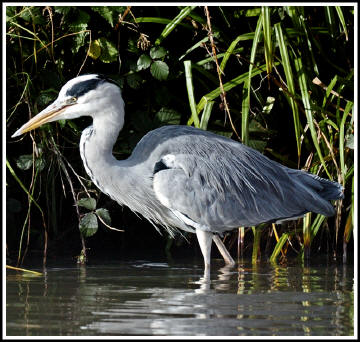Article
Grey Heron
Latin Name: Ardea cinerea The first birds may have
returned to the nesting sites during December with the numbers building up
slowly during January and the more established breeding pairs present at their
old nests by the beginning of February. The young first time breeding pairs will
not arrive until the end of February or even into March.
February is a time for
re-establishing their pair bonds and rebuilding their nests. During this process
they are very vocal and perform a display of bowing and wing spreading movements
as well as carrying large numbers of sticks to their nests. Herons although a
large bird, do nest in trees in colonies, called a Heronry, so a tree can have a
number of nests for different mating pairs and the process of collecting sticks
is an intriguing process to watch as both birds seem to go off and collect
together new nesting material, but as they are away their neighbours will come
and take the new stocks for their own nests.
|
  
|
Identification
Herons have pink bills during
the mating season and seem to perform an important part of the breeding display.
The first eggs usually arrive in the third week of February at which time their
bills return to the normal yellow colour and become pink again the eggs become
lost or are stolen as the birds need to start the breeding process again. An
area close by to the Heronry will see large numbers of off-duty birds, usually
males, stand motionless as part of their ritualised breeding behaviour. Once the
young are born, both parents will both collect food and also continue to clean
out and rebuild their nests.
Mild winters have been kind
to them in recent years, they will struggle to find enough food when lakes and
ponds freeze and the soil turns hard meaning they can't get at the worms for
their young. If we get a prolonged cold snap nesting will be delayed.
|
Animal
Facts
In Britain: All year round
Habitat: Waterside, wet meadows
Food: Fish, amphibians, worms, small
mammals, insects. Seeks food on banks of shallows water, in meadows and fields.
Breeding: February - June, 3-5 eggs,
incubation 25-28 days, young fledge 50-55 days. Colonial nester usually in tall
trees, sometimes in reedbeds.
|
Conservation
Status

Least Concern |
Heron Hotspots
Herons are quite a common
site within the UK now, we have seen individuals on river banks, at canals and
of course in the wetland centres. Some places you can go and see Herons in their
Heronry during the breeding season, February onwards include:
RSPB centres at
But also at other locations
such as:
-
Rutland Water,
Leicestershire

-
Connahs Quay,
Deeside, Wales

-
Low Barn's Nature Reserve,
Witton-le-Wear, Co Durham

-
Cley Marshes, Norfolk

-
Chichester Harbour,
West Sussex

-
Falls
of Clyde Wildlife Reserve, Lanark, Scotland

-
Regents Park, London

|